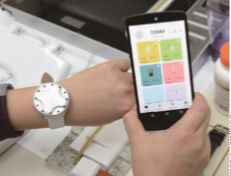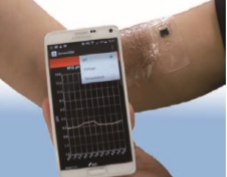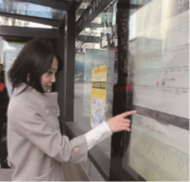Recently, Korean researchers have developed a product called Touch Tag which is able to extract information as soon as a person touches an object. It will help to collect data from the elderly and the disabled regarding their movements and conditions after as it is commercialized. This technology is based on Human Body Communication (HBC), and it will not only improve the quality of people’s lives but can also be applied to various fields including identity verification and healthcare. Therefore, the Sungkyun Times (SKT) now looks at what HBC is, its strengths and weaknesses, the possible way for its development, and the expected effects.
What Is Human Body Communication?
-The Advent of Human Body Communication
Human Body Communication (HBC) is a technology which utilizes a human body as a medium through which electric currents pass so that the body turns into a medium of communication. Originally, wire communications using cables and wireless communications using air as an intermedium have been used. HBC, however, is more convenient for gathering and analyzing data automatically in the user’s everyday life, and it works even without consciousness. When a user sets a specific purpose, such as tracking one’s physical conditions, HBC collects data and offers information based on the target. The introduction of HBC emerged as Bio-Technology (BT) and Nano Technology (NT) are combined with Information Technology (IT). Traditional communication technology was combined with BT to enhance the streaming of the current flow on the human body. With the advanced technology, NT was required to devise wearable or implantable devices. Moreover, the desire for the humanism of communication and direct contact in person has become more critical due to social isolations caused by development of technologies. Therefore, HBC started from the idea that human beings should directly be involved in the communication process, not through machine. T.G. Zimmerman first revealed HBC at Massachusetts Institute of Technology (MIT) in 1995. Based on this, Nippon Telegraph and Telephone corporation (NTT) in Japan presented “Red Tacton” in 2005. Red Tacton is a combination of the words Red, Touch, and Action. With this technology, users can unlock the door by just touching a door without any key. Unlike fingerprint recognition, which compares a saved fingerprint photo with user’s fingerprint, Red Tacton verifies identification by touching any part of the body using HBC. In Korea, research regarding HBC started in 2002, led by the Electronics and Telecommunications Research Institute (ETRI). The ETRI is working on experiments for commercialization after finishing technological development.

Current State of Human Body Communication
Currently, HBC technology is mainly focused on the field of identity (ID) verification and healthcare.
● Identity Verification
The HBC ID system enables personal identification. For instance, people do not have to use a car key, since the door opens as soon as they put their hand on the handle. HBC verifies identity at a school library as a student reaches the library door, without the use of a student ID card. As the body itself can be a key or a security card, the current complicated verification process can be simplified.
● Health Care
By attaching sensors to the body, electrocardiograms (ECG), weight, temperature, blood pressure, and the amount of exercise undertaken can be measured by sending data about physical condition through a wireless device. Gathered data is combined with the Internet of Things (IoT) technology in order to be used in various services, including care services. For instance, a sensor can be attached to a person’s body to measure the amount of water that he drinks a day. If he were to drink less water than usual, then that information would be sent to the guardian or the doctor. Moreover, for the disabled who are without arms or legs, HBC can measure and read their brainwaves and move their prosthetic hand or leg in a desired way. In this way, HBC is currently helpful in the areas of disabled people and senior welfare.

Advantages and Limitations of Human Body Communication
-Advantages of Human Body Communication
● Technological Efficiency
Compared to other communication technologies, HBC significantly reduces electric consumption. It does not require any other external currents but only uses currents which flow inside of the human body to make data transactions. It can transfer information about ten times faster than traditional wire communication. HBC does not need any other connection except for the touch of a body, which enables a more comfortable and faster interface.
● Superior Security
Wireless communication has security risks as it transmits data through the air, which is hard to be limited. In contrast, HBC limits the transfer range to only inside the body, so it is more secure and reliable than other communication systems. Combining HBC with other technologies, such as biometrics, will enhance the function of HBC to provide stronger security services.
● User Customized
As HBC can only work through human contact, it can offer the right information that suits each user’s unique situation. Similar traditional technologies, which were based on camera and motion sensors, can only identify whether a person is moving or not. HBC, however, can recognize what exact behavior he or she is doing, and provide services accordingly. For instance, at the time a user touches a printer, the printer can print the documents that the user saved before, without clicking the print button on a computer. Moreover, with Personal LifeLog (PLL) technology, more detailed information can be provided. PLL is a technology which records a user’s life every day, all of the time. It unconsciously saves all the data about what the user experiences at any given place and time. For instance, after measuring the amount of a user’s exercise with HBC, PLL can analyze where the user runs, at what speed, and for how long they rest, and set a personalized plan for better exercise effects.
-Limitations of Human Body Communication
● Limited Communication Range
Using HBC, the communication range is limited to 2-3 meters around the human body. Therefore, there is the possibility that HBC would not be able to enter into the mass market. Besides, as HBC communicates at a low frequency, which has a narrow frequency range, it cannot transfer a large amount of data. At such low frequencies, only text files can be transferred, which results in incomplete transmissions when sending photo or video files. Hence, when transmitting a large volume of data, traditional wireless communication is more preferable than HBC. Moreover, to send the data which is collected by HBC, direct intervention by a user is inevitable. For example, to use health data which has been efficiently compiled by HBC, they have to be sent to the user’s doctor. It is impossible, however, to transmit data through HBC unless the user and the doctor meet face to face. As a result, wired or wireless communication has to be used for transmitting the data.
● Stability
Even a small movement of the human body can create noise due to environmental factors, such as static electricity. Apart from static electricity, currents from other external electric devices like smartphones can also affect data transmission stability. If the transition process is under unstable conditions, data cannot be transmitted. Moreover, biological activities, such as heartbeats and intestinal motility, can also cause noise. External temperature, perspiration conditions, and various other factors can also create unstable network conditions.
● Safety
There is no definitive result regarding HBC’s effects on the human body when internal currents meet electronic devices. The research about the effect of an electric current on the body is essential for practical use of HBC in real life. Moreover, as not all humans have the same reaction to electricity that flows inside the body, not every device can use a constant amount of power. Although using the same amount, some people might be fine, but to others it might be fatal.
Despite these limitations, HBC’s advantages are superior, which has led researchers to develop more and supplement current HBC technologies.
Future Effects of Human Body Communication
-Resolution for the Marginalized from Technology
HBC provides an interface which anyone can use quickly and conveniently. Therefore, it enables cultural and generational exchange in society without users being isolated from IT technologies. To be specific, it can prevent crimes which target the people who are not used to high technology. In reality, many elderly people have exposed their ID numbers and Personal Identification Numbers (PIN) of their bank accounts for getting help by others, as they are not used to using Automated Teller Machines (ATM). HBC, however, enables a person to record personal information and passwords inside the human body, and a simple touch helps them to complete their bank services. Moreover, if the disabled’s data has not been collected for a long time via HBC, it can declare an emergency, and take appropriate action. In aspects of price, HBC is relatively cheaper than other forms of communication technology, which leads to easier installation for those who have not been able to afford existing technology. With a simple touch which represents interest, HBC creates a new paradigm which is more convenient for users.
-Advancement of New Industrial Areas
● Business Transaction
When HBC is commercialized, it will save time as the purchasing process can be simplified. If buyers save payment information on their devices in advance, a straightforward touch to the cashier desk can make a purchase. Receipts also automatically flow into the buyer’s device, which can replace current paper or online receipts. Connection with the internet is inevitable to receive online receipts, which means that the customers cannot check without the internet. In contrast, as HBC does not require the internet, customers can check the receipts at any time they want.
● Transportation
HBC technology can replace current transportation cards. Through HBC, payment can be made by touching a hand when one gets on a subway or a bus. Moreover, when a user saves a specific destination in a device and reaches the screen at the station, HBC shows the bus number and arrival information on the screen by reading the user’s device. Therefore, the user does not have to open a map on their phones. It also shows several optimal routes to the destination, enabling the user to choose one of them. Moreover, users can pay a total fee even before he or she gets onto the transportation by touching the screen at the station.

HBC appears to enhance people’s convenience through its interaction with various industries. Along with commercialization, HBC is expected to produce differentiated products and services compared to current society. It is time to start paying attention to HBC, which might become integral to our future lives
